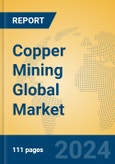Refined copper output hit 27.6261 million tons, impacted by operational constraints and smelter maintenance in Chile, Indonesia, Sweden, and the U.S., while consumption rose to 27.6919 million tons, driven by China’s robust demand and renewable energy growth, resulting in a supply deficit. The industry is characterized by its sensitivity to supply chain disruptions and strong demand from electrification trends.
Market Size and Growth Forecast
The copper mining market is expected to reach USD 175-185 billion by 2025, with a CAGR of 2%-3% through 2030, driven by electrification and infrastructure growth, tempered by supply volatility.Regional Analysis
South America, led by Chile and Peru, expects growth of 2%-3%, with Chile’s market trends showing recovery from disruptions. Asia Pacific, notably China, anticipates growth of 2.5%-3.5%, fueled by consumption strength. North America projects growth of 1.5%-2.5%, tied to renewable energy projects. Europe expects growth of 1%-2%, driven by green tech demand. Africa anticipates growth of 1.5%-2.5%, with Zambia and the DRC expanding output.Application Analysis
- Metal Processing Industry: Projected at 2%-3%, dominates due to electrical and construction uses, with trends toward high-conductivity copper.
- Chemical Industry: Expected at 1.5%-2.5%, used in catalysts, with steady niche growth.
Type Analysis
- Open-pit Mining: Projected at 2%-3%, the primary method, with trends toward automation.
- Underground Mining: Expected at 1.5%-2.5%, used for deeper deposits, with safety and tech advancements driving growth.
Key Market Players
- First Quantum: A Canadian firm, it targets high-growth copper regions.
- Glencore International: A Swiss leader, it excels in global copper trading.
- Anglo American: A UK-based company, it focuses on large-scale projects.
- Codelco: Chile’s state-owned giant, it dominates production.
- KGHM: A Polish firm, it integrates mining with refining.
- Southern Copper Corp: A U.S.-Mexican player, it serves North and South America.
- Freeport-McMoRan: A U.S. leader, it operates major copper mines.
- BHP Billiton: An Australian firm, it diversifies into copper.
- Antofagasta: A Chilean company, it focuses on premium deposits.
- Rio Tinto: An Australian giant, it targets high-quality copper.
Porter’s Five Forces Analysis
- Threat of New Entrants: Moderate. Capital needs limit entry, but demand attracts investment.
- Threat of Substitutes: Low. Copper’s conductivity ensures dominance.
- Bargaining Power of Buyers: Moderate. Diverse buyers balance supplier power.
- Bargaining Power of Suppliers: High. Concentrated production strengthens leverage.
- Competitive Rivalry: High. Global firms compete on scale and cost.
Market Opportunities and Challenges
Opportunities
- Renewable Energy: Electrification drives copper demand.
- Infrastructure Growth: Urban projects sustain use.
- Supply Expansion: New deposits in Africa offer potential.
- Tech Advances: Improved extraction boosts yields.
- Global Demand: Industrialization supports growth.
Challenges
- Supply Disruptions: Geopolitical and operational risks persist.
- Environmental Costs: Regulations increase expenses.
- Price Volatility: Market fluctuations impact profitability.
- Smelter Constraints: Refining bottlenecks limit output.
- Substitution Risks: Aluminum competes in some uses.
This product will be delivered within 1-3 business days.
Table of Contents
Companies Mentioned
- First Quantum
- Glencore International
- Anglo American
- Codelco
- KGHM
- Southern Copper Corp
- Freeport-McMoRan
- BHP Billiton
- Antofagasta
- Rio Tinto








